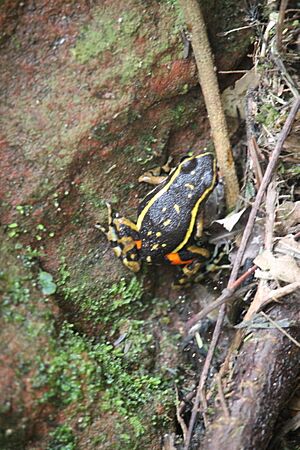Ameerega boehmei facts for kids
Quick facts for kids Ameerega boehmei |
|
|---|---|
 |
|
| Conservation status | |
| Scientific classification |
Ameerega boehmei is a type of frog that belongs to the Dendrobatidae family. This family is also known as the poison dart frog family. This frog is found only in the Chiquitania region of Bolivia. Specifically, it lives in the Santa Cruz Department.
You can find Ameerega boehmei in two separate rocky areas. These are called Serranía de Santiago and Serranía de Chochis. This frog looks a lot like another species, Ameerega flavopicta. People sometimes confuse the two. The name boehmei was chosen to honor a scientist named Wolfgang Böhme. He helped the scientists who discovered this frog. A common name for this frog is Boehmei's poison arrow frog.
Contents
What Does Ameerega boehmei Look Like?
Adult Ameerega boehmei frogs are quite small. They measure about 19 to 35 millimeters (0.75 to 1.4 inches) long. This measurement is taken from their snout to their rear end. Female frogs can be the largest, but males and females are generally similar in size.
Body Shape and Skin
These frogs have a slim body. Their head is a bit narrower than the rest of their body. The front part of their head, called the snout, is rounded. They have a clear eardrum, or tympanum, on the side of their head. Their fingers and toes do not have any webbing between them. The skin on their back feels a little bumpy.
Colors and Patterns
The main color on their back is black. They have bright yellow lines along their sides and near their mouth. They also have yellow spots or dots on their back. Their legs are brown with black marks, or black with bright yellow marks. The underside of their body is light gray to light brown. It often has black patterns that look like marble.
How Males Call
Male Ameerega boehmei frogs make a special call to attract females. This call sounds like a series of short, rising notes. The main sound frequency is around 2.7 to 3.2 kilohertz.
Where Do Ameerega boehmei Live?
Ameerega boehmei frogs live in rocky areas. These areas are part of open Cerrado grasslands. They are found at heights of about 500 to 1200 meters (1,640 to 3,940 feet) above sea level.
Daily Life and Water
These frogs are diurnal, meaning they are active during the day. They usually stay close to slow-moving streams. However, you can sometimes find them up to 50 meters (164 feet) away from water.
Reproduction and Young Frogs
They seem to reproduce during the wet season. This season lasts from November to April. The female frogs lay their eggs on land. After the eggs hatch, the adult frogs carry the young tadpoles. They take them to shallow pools or temporary puddles. The tadpoles then continue to grow and develop there.
How Are Ameerega boehmei Protected?
In some places, there are many Ameerega boehmei frogs. But in other areas, their numbers seem to be going down. A big threat to these frogs is fires. These fires are often started to clear land for cattle to graze. This practice helps expand pasture land.
Luckily, Ameerega boehmei can be found in a protected area. This area is called the Tucavaca Valley Municipal Reserve. This reserve helps protect their habitat and their populations.


